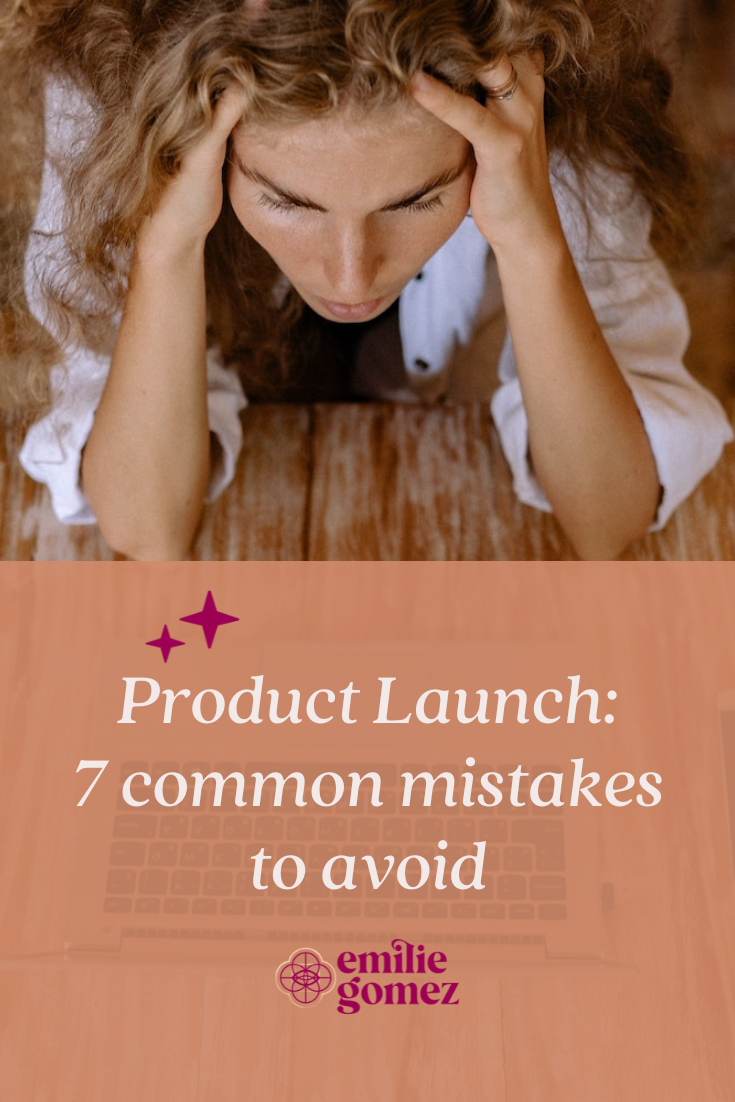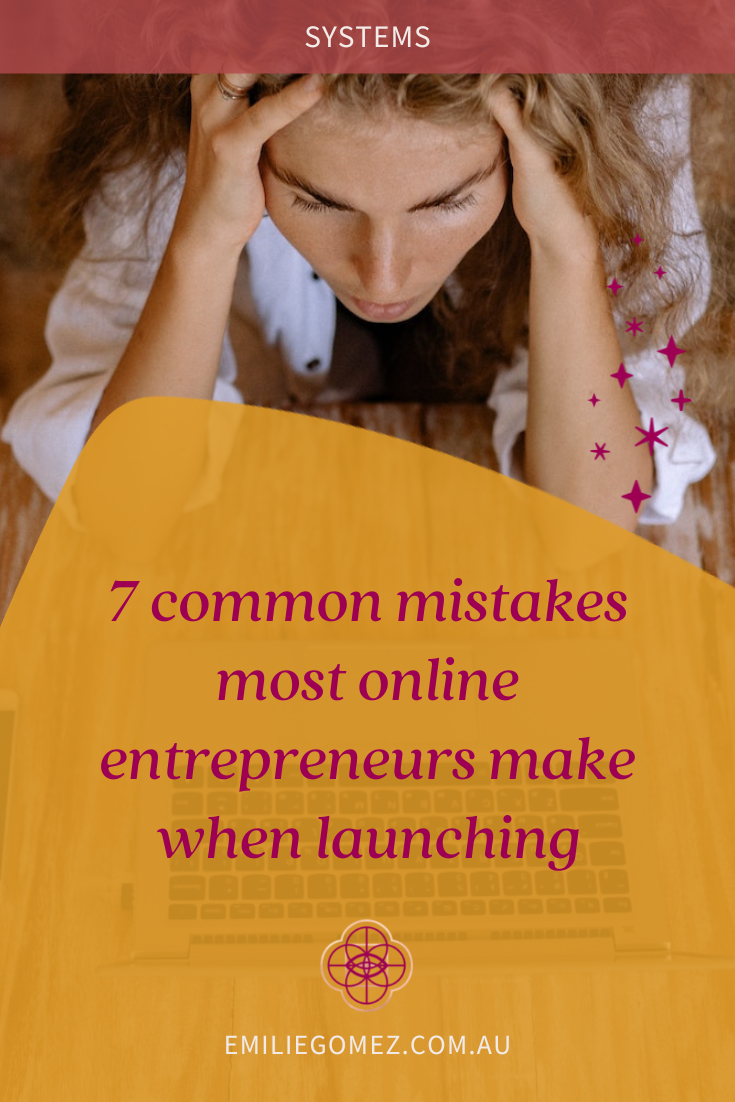No time to read? Watch the replay.
Launches: Hate Them or Love Them?
I asked this question to my community recently. The response was mixed. And the same goes with my clients, whether it’s their first launch or they’ve done it multiple times.
Although, the more they do it, the more they seem to enjoy it. Not because they make more money with each launch but because it’s easier and more manageable each time. With each launch, they become more familiar with their ideal client, and they discover how to speak to them directly through engaging copy and spot-on messaging.
They also learn what they’d do differently in their next launch. Typically, they have a long list of things they wished they’d known before their first launch to make the whole process a lot less overwhelming and energy-draining.
It doesn’t have to be that way for you. You don’t have to wait for your tenth launch to find out all the things you should have done in your first launch! Here’s a list I’ve compiled for you with 7 common mistakes that business owners make with their digital launch and how you can avoid them. Bookmark this page and come back it before you embark on your next launch!
Mistake #1: lack of clear goals
An unfortunate trend that I’ve noticed with all my clients when they first come to me is that they don’t have clear goals about their launch.
They know they want to launch their new online offering and they know what their offer is. Typically, they also have a pretty clear idea about some of the tactics they want to implement, such as introducing their offer via masterclass.
But that’s usually the extent of what they know.
In most cases, they haven’t thought about their pre-prelaunch and how to get their ideal clients into their masterclass. They also haven’t thought of how many participants they need in the masterclass. And usually, that’s because they haven’t even considered how many enrollees they want in their program.
Most online discussions about launching focus on the financial results of launching and doing a 5 or 6-figure launch. And although it’s an admirable goal to have, what does it mean for YOUR business and YOUR programme? You need to relate that amount back to the number of people who need to enrol to achieve that number.
Suppose your goal is to make $10K from a $100 course. It means you have to enrol 100 people. On the other hand, if your goal is $10K and you’re selling a $2,000 programme, you’ll only need 5 sign-ups.
I know this may seem very obvious. But the perspective has now changed. You’re no longer aiming for $10K. You now know how to make those $10K. By enrolling either 100 or 5 people. Having this specific number of enrolments allows you to assess how realistic your goal is and how much effort you need to put into your pre-prelaunch.
Is this realistic for YOU based on your current situation – number of subscribers on your list, social media followers and how active/engaged your community is? Is your audience large enough right now to reach that goal? Considering a conversion rate of 2%, you’ll need either 5,000 or 250 people on your list. 2% is an average conversion rate across industries. You’ll want to check the conversion rate in your industry.
This is a very simplified way of looking at it, as it’s only looking at the conversion from your list. You’ll also want to take into account the conversion rate in the other parts of your funnel (e.g. conversion from your masterclass).
Mistake #2: lack of reporting
Apart from preventing you from spending time and/or money on a launch doomed to fail (because your audience isn’t big enough to start with), setting goals is critical to ensure you know what to track and monitor how your launch is progressing.
You need to know how successful your launch was when you close your cart (assuming you’re not doing an evergreen launch). This will help you review what worked and what didn’t and will inform the changes you need to make for your next launch. We’ll talk more about this below but for now, what you need to know is that the only way you can make this kind of decision is by having the data behind it.
Thinking about reporting after you close your cart is too late. Often, the data that you need isn’t available by default. You’ll have to set up systems first to start collecting it. Sometimes you can’t do it retroactively. So thinking about your goals at the start will help you identify the reports that you need and determine how to collect the data if it’s not readily available.
Reporting on how your launch went isn’t enough, though. You also need to know how it’s going while it’s in progress, so you can adjust your strategy as you go if need be. Suppose you need to have 1,000 people on your list to reach your $10K goal and a few days before the start of your pre-launch, you only have 700 subscribers. At that stage, you can decide to:
- Go ahead with your launch and revise your goals. $10K may become your stretch goal, but a most realistic goal could be $7K. (Side note: adjusting goals as you get more data is a great strategy to avoid falling into the traps of the negative self-talk that may arise when you don’t reach your goal.)
- Delay your launch by a couple of weeks (or longer) to give you time to reach your 1,000 subscribers goals.
- If you’re running ads (and they’ve been performing well), you may want to increase your budget, so you reach more people.
These are just some examples of actions you can take. It’ll be different for everyone. But you can see that having data helps you make informed decisions.
Mistake #3: lack of a customer journey map
Another mistake I often see when clients first come to me is that they don’t have a clear map of what they’re doing with their launch and what journey they’re taking their audience on. They only think about their launch as a sequential process: Pre-Prelaunch (if they even think about this) -> Pre-launch -> Launch.
The bulk of your launch may be sequential, but you may be missing out on many other opportunities if you don’t have a clear picture of what your funnel is. Writing or drawing the various steps – whether on paper or digitally – will help you identify all the potential touchpoints. You don’t have to act on all of them, but it’ll help you customise your emails and messaging further by meeting your audience where they are.
For example, do you want to send the same email to people who registered for the masterclass and didn’t attend and to people who showed up for the masterclass? The fact they didn’t turn up may be a sign that they are time-poor. So when you send out the replay, you may want to give them a short recap (as they may not even have time to watch the replay).
By not mapping out your customer journey, you also risk not identifying all the content that you need to write. Too many times, I’ve seen business owners forget to provide copy for a thank you page or a thank you email. As a result, they write something very generic at the last minute. Your thank you page is another opportunity to connect with your customers. So make it simple and not generic. Show your personality. Provide more value.
Another mistake I often witness as a result of not having a customer journey map is that you focus all your energy on your masterclass and your open cart period to the detriment of your onboarding process. Onboarding is a critical part of your client journey when they’ve decided to work with you. You want to make sure they’re happy from the beginning. And yet, this part is often ignored or forgotten. You need to consider what happens after people enrol in your course or program, such as:
- Do they need an invoice?
- Do they get their login details straight away?
- If not, do you send them an email to let them know the timeline?
Mistake #4: backend se up incorrectly
Your customer journey map will show you all the touchpoints and help you identify all the content you need to write. It’ll also show you all the systems and tools at play and which ones need to talk to each other.
Integration – how applications and software communicate with each other – is a critical part of your launch and will have a considerable impact on its success. And yet, it’s also something that most business owners neglect because:
- They feel overwhelmed by tech, and therefore they go for the easy option.
- They don’t know what they need – they just want to launch!
- They don’t want to spend the money by upgrading their systems or hiring the right support.
However, shortcuts and the wrong systems are the sure way to create an underwhelming and incohesive customer experience. You may also not be maximising your opportunities to connect with your audience.
The most common mistake I see here is not connecting your webinar platform with your email marketing system. Instead, you rely solely on your webinar platform for the registration and email reminders. This is a problem because you may not be able to customise it the way you need. The registration page needs to tell your ideal client why they need to attend your masterclass. The email reminders are a great way to reinforce why they need to show up live but also to provide more value in the lead up to the masterclass.
To avoid this, you may decide to send emails via your email marketing system too. Now, you’re doubling up on emails. Plus, you’re telling your subscribers to look for another email to find the link to join. This isn’t a good user experience at all. People get too many emails these days. You need to make it easy for them to join your webinar.
Not integrating your system means that you may need to rely on manual processes. And this is another faux pas! It may be quite a straightforward step and not seem like a big deal, but what happens if the person who needs to perform this step is sick or can’t perform that action in time to kick off the next step?
Mistake #5: neglecting self-care
Launches are intense. You need to create a lot of content and be visible:
- in the lead up to the launch (to create awareness about your offer),
- during the launch (to support anybody who has questions and connect with your audience)
- after the launch (to onboard your new clients and start planning for the next launch and build on the momentum you’ve just created)
Many business owners lose steam halfway through their launch because putting yourself out there can be challenging and energy-draining, especially if you’re an introvert. Having goals might keep you going if you’re motivated in that way. But you’ll most likely end up burning yourself out.
What you need to do instead is schedule in plenty of self-care during your launch. Planning a launch isn’t just about all the content you need to create to get your audience’s attention and sell your offer. If you’re not well, it’ll show in your content and the way you show up. You won’t be able to support and engage with your audience as well as you’d like to. So, you need to include self-care activities in all phases of your launches. This can be as simple as:
- Taking breaks
- Drinking plenty of water
- Doing a few breathing exercises
- Going out for a walk
- Taking a nap
- Going to bed early
Mistake #6: moving on too quickly
This error may be a result of Mistake #2 (lack of reporting). If you haven’t set up any reports, you have no way to review how your launch went, and so you move on to the delivery part of your offer or to your next launch.
On the other hand, you may have some data, but you focus too much on the end result. Did you have a 5-figure (or 6-figure) launch? Inevitably, you judged your launch as pass or fail, rather than consider what worked and what didn’t.
You do need to review how your launch went, based on your goals. You also need to deep dive into the numbers and look at what you may want to improve for your next launch. You want to take on all the feedback you’ve received, either directly (e.g. comments on social media posts) or indirectly (e.g. email click rates).
From there, you can determine what the reasons behind this feedback may be and make a list of ways to remedy it (e.g. refine your messaging and better highlight what’s included in the program). You can then schedule this in your work management tool, and decide when the best time to make those changes are. Everyone is different. You can do it straight away, chip away at it until your next launch, or schedule additional time ahead of your launch to do it.
Although you can postpone making the changes to later, establishing the list of required changes is something you want to do sooner rather than later, because:
- The feedback will be fresh in your mind right after your launch. So you’ll know what you’d like to do differently then.
- It’ll allow you to plan your next launch better, and avoid a few stressful weeks a few days ahead of your launch when you realise the amount of work required.
- It’ll allow you to better plan for the assistance that you need for your next launch. Too often, business owners think about the help they need right when they need it. Most service providers won’t be able to just drop everything to join your team and assist you during your launch. You want to give them the time they need to do their work correctly, provide you with the support you need and not burn themselves out in the process.
When you move on too quickly, you also miss out on the opportunity to build your waitlist and capitalise on the momentum you’ve just created. Since your audience is already aware of your offer, all you need to do is let them know the cart is now closed, but that you’ll be relaunching your digital product in a few months. Tell them to jump on the waitlist if they want to be the first to know and save some money. You don’t have to offer special pricing, but you do have to have an incentive for them to join the waitlist now rather than wait for the next launch.
Mistake #7: not taking responsibility
One of my clients had a manual step in their process (Mistake #4). They needed their VA to upload data from one system to another because they hadn’t set up any integration. It’d never been an issue for them before… until the VA had an emergency and wasn’t able to upload the list on time. As a result, subscribers were tagged incorrectly in the email marketing system and were sent the wrong email.
This could have been avoided in a few ways.
First, with integration, as mentioned in Mistake #4. In the case of that client, it wasn’t possible as there was an issue with their systems, and the service provider didn’t get back to them on time. (Side note: if they’d plan the launch earlier, and work on setting up the systems in between launches, rather than a couple of weeks out then it could have been avoided!)
Another way to avoid this situation in your business is by creating redundancy, meaning you want to have someone who can take over in case of an emergency. If your business is just you and your VA, then YOU are the backup person. It doesn’t mean that the backup person knows everything about the first person’s job at all times. But, you should have someone who can do the job when given a set of instructions. That’s where having a Standard Operating Procedure manual comes in handy.
Having a backup person is excellent, but it’s not enough if you don’t even know what tasks need to be done! As the business owner, you need to know what everyone on your team does during the launch. It’s not about micromanaging. It’s about knowing everybody’s role and how your whole launch works, especially if there are any manual steps.
This is YOUR launch and YOUR business. You’re responsible for its success.
Conclusion
The best way to avoid these common mistakes is to plan well ahead of your launch.
I know as a creative entrepreneur, connected to your intuition, you may feel reluctant to plan. You’d rather go with the flow. But launches have too many moving parts and are too important for your business for you to just put them together at the last minute.
Give yourself and your business the best chance to succeed. Plan ahead, set realistic goals and create reports that will allow you to review how your launch went in detail, instead of a simplistic pass or fail. Make sure to allow for plenty of self-care time by scheduling in sleep, enrolling in a meditation program or creating a meal plan.
The best time to plan your next launch is when you’ve finished one launch and have replenished your energy. Not when you realise that you’re not gonna meet your financial goal this month and you need a quick injection of cash.
If you’re looking to launch your digital offering in the next 6 months, now is the time to plan and set solid foundations in place so that you can launch with ease. Reach out to find out how I can support you in this process.













